Connected Car: Challenges and Opportunities for the Automotive Industry
In this article, take a look at the challenges and opportunities for the automative industry when it comes to connected car technology.
Join the DZone community and get the full member experience.
Join For FreeThe development of connected car technology accelerated digital disruption in the automotive industry. Verified Market Research valued the connected car market at USD 72.68 billion in 2019 and projected its value to reach USD 215.23 billion by 2027. Along with the rapid growth of this market’s worth, we observe the constant development of new customer-centric services that goes far beyond driving experience.
While the development of connected car technology created a demand for connectivity solutions and drive-assistance systems, companies willing to build their position in this market have to face some significant challenges. This article is the first one of the mini-series that guides you through the main obstacles with building software for connected cars. We start with the basics of a connected vehicle, then dive into details of prototyping and providing production-ready solutions. Finally, we analyze and predict the future of verticals associated with automotive – rental car enterprises, insurers, and mobility providers.
This series provides you with hands-on knowledge based on our experience in developing production-grade and cutting edge software for the leading automotive and car rental enterprises. We share our insights and pointers to overcome recurring issues that happen to every software development team working with these technologies.
What Is a Connected Car?
A Connected Car is a vehicle that can communicate bidirectionally with other systems outside the car, such as infrastructure, other vehicles, or home/office. Connected cars belong to the expanding environment of devices that comprise the Internet of Things landscape. As well as all devices that are connected to the internet, some functions of a vehicle can be managed remotely.
Along with that, IoT devices are valuable resources of data and information that enable further development of associated services. And while most car owners would describe it as the mobile application paired with a car that allows users to check the fuel level, open/close doors, control air conditioning, and, in some cases, start the ignition, this technology goes much further.
V2C – Vehicle to Cloud
Let’s focus on some real case scenarios to showcase the capabilities of connected car technology. If a car is connected, it may also have a sat-nav system with a traffic monitoring feature that can alert a driver if there is a traffic jam in front of them and suggest an alternative route. Or maybe there is a storm at the upcoming route and navigation can warn the driver. How does it work?
That is mostly possible thanks to what we call V2C – Vehicle to Cloud communication. Utilizing the fact that a car is connected, and it is sending and gathering data, a driver may also try to find it, in case it was stolen. Telematics data is also helpful to understand the reasons behind an accident on the road – we can analyze what happened before the accident and what may have led to the event. The data can be also used for predictive maintenance, even if the rules managing the dates are changing dynamically.
While this seems just like a nice-to-have feature for the drivers, it allows car manufacturers to provide an extensive set of subscription-based features and functionalities for the end-users. The availability of services may depend on the current car state – location, temperature, and technical availability. As an example: during the winter, if the car is equipped with heated seats and the temperature drops under 0 celsius, but the subscription for this feature expires, the infotainment can propose to buy the new one – which is more tempting when the user is at this time cold.
V2I – Vehicle to Infrastructure
A vehicle equipped with connected car technology is not limited to communicating only with the cloud. Such a car is capable of exchanging data and information with road infrastructure, and this functionality is called V2I – Vehicle to Infrastructure communication. A car processes information from infrastructure components – road signs, lane markings, traffic lights to support the driving experience by suggesting decision makings. In the next steps, V2I can provide drivers with information about traffic jams and free parking spots.
Currently, in Stuttgart, Germany, the city’s infrastructure provides the data live traffic lights data for vehicle manufacturers, so drivers can see not just what light is on, but how long they have to wait for the red light to switch to green again. This part of connected car technology can rapidly develop with the utilization of wireless communication and digitalization of road infrastructure.
V2V – Vehicle to Vehicle
Another highly valuable type of communication provided by connected car technology is V2V – Vehicle to Vehicle. By developing an environment in which numerous cars are able to wirelessly exchange data, the automotive industry offers a new experience – every vehicle can use the information provided by a car belonging to the network, which leads to a more effective communication covering traffic, car parking, alternative routes, issues on the road, or even some worth-seeing spots.
It may also significantly increase safety on the road, when one car notifies another that drives a few hundred meters behind him that it just had a hard breaking or that the road surface is slippery, using the information from ABS, ESP, or TC systems. That has not just an informational value but is also used for Adaptive Cruise Control or Travel Assist systems and reduces the speed of vehicles automatically increasing the safety of the travelers. V2V communication makes use of network and scale effects – the more users have connected to the network, the more helpful and complete information the network provides.
The list of use cases for connected car technology is only limited by our imagination but is excelling rapidly as many teams are joining the movement aiming to transform the way we travel and communicate. Connected Car revolution leads to many changes and impacts both user experience and business models of the associated industries.
How Connected Car Technology Impacts Business Models of the Automotive Industry
Connected cars bring innovative solutions to the whole environment comprising the automotive landscape. Original Equipment Manufacturers (OEMs) have gained new revenue streams. Now vehicles allow their users to access stores and purchase numerous features and associated services that enhance customer experience, such as infotainment systems. By delivering aftermarket services directly to a car, the automotive industry monetizes new channels. Furthermore, these systems enable automakers to deliver advertisements, which become an increasing source of revenue.
The development of new technology in automotive creates a similar change as we observed in the mobile phone market. When smartphones equipped with operating systems had become a new normal, significantly increased the number of new apps that now allow their users to manage numerous services and tasks using the device.
But it is just an introduction to numerous business opportunities provided by connected cars. Since data has become a new competitive advantage that fuels the digital economy, collecting and distributing data about user behavior and vehicle performance is seen as highly profitable, especially when taking into account the potential interest of insurers providers.
Assembled data while used properly gives OEMs powerful insights into customer behavior that should lead to the rapid growth of new technologies and products improving customer experiences, such as predictive maintenance or fleet management.
The Architecture Behind Connected Car Technology
Automotive companies utilize data from vehicle sensors and allow 3rd party providers to access their systems through dedicated API layers. Let’s dive into such architecture.
High-Level Architecture
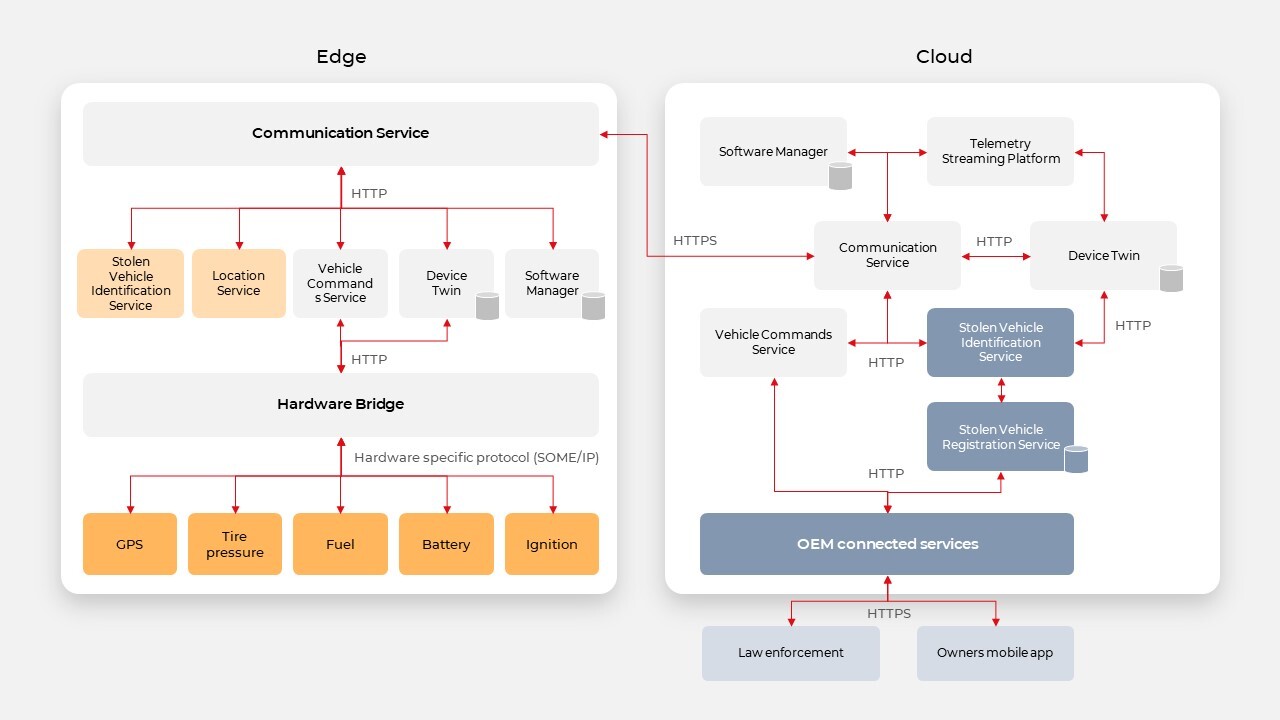
System Components
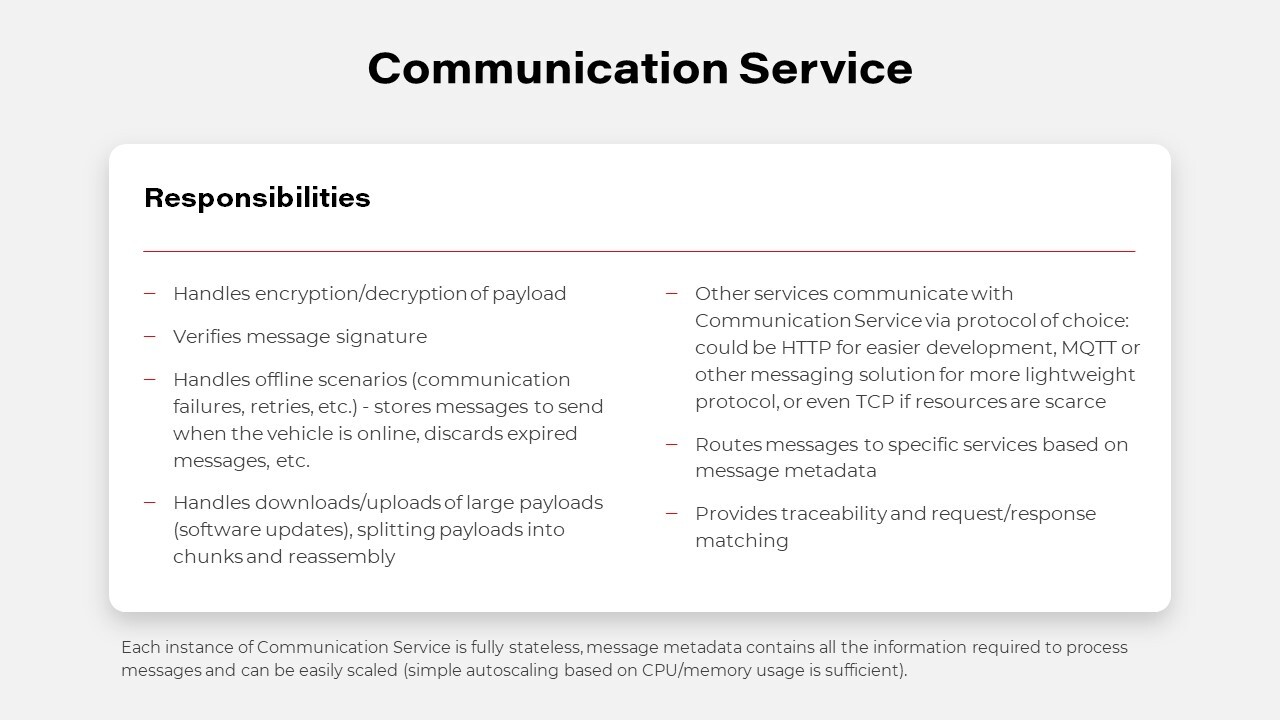
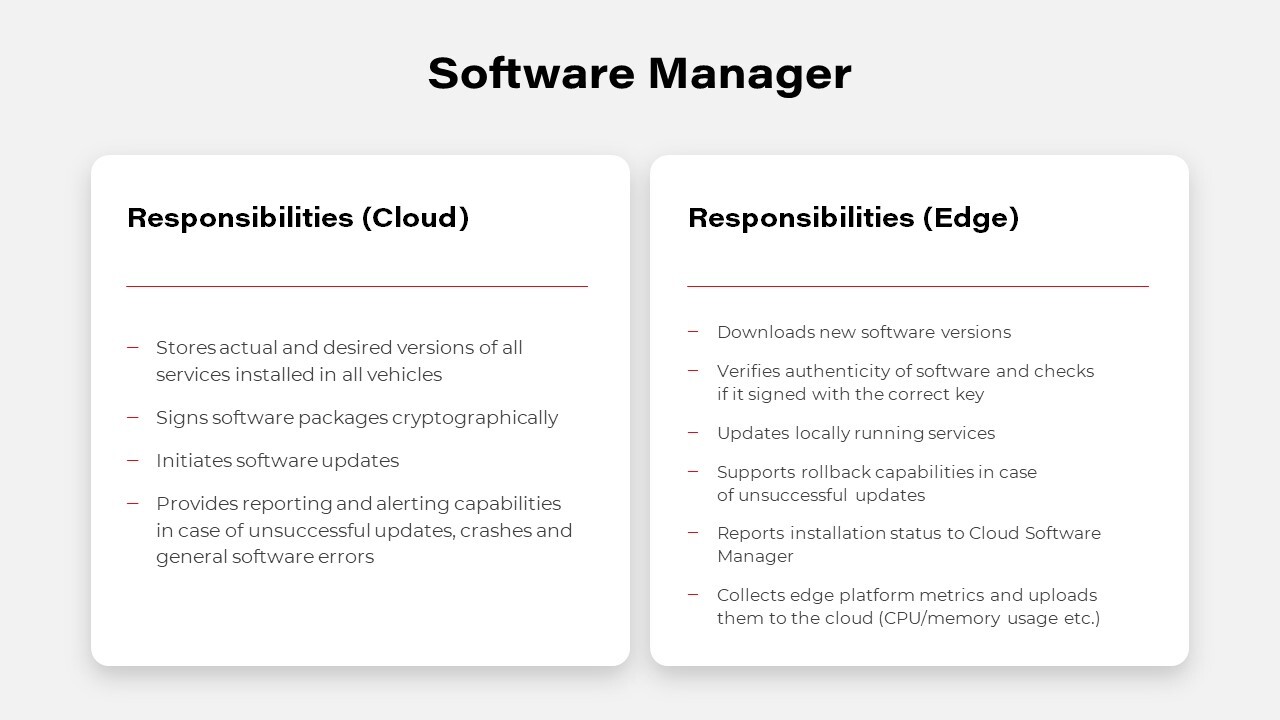
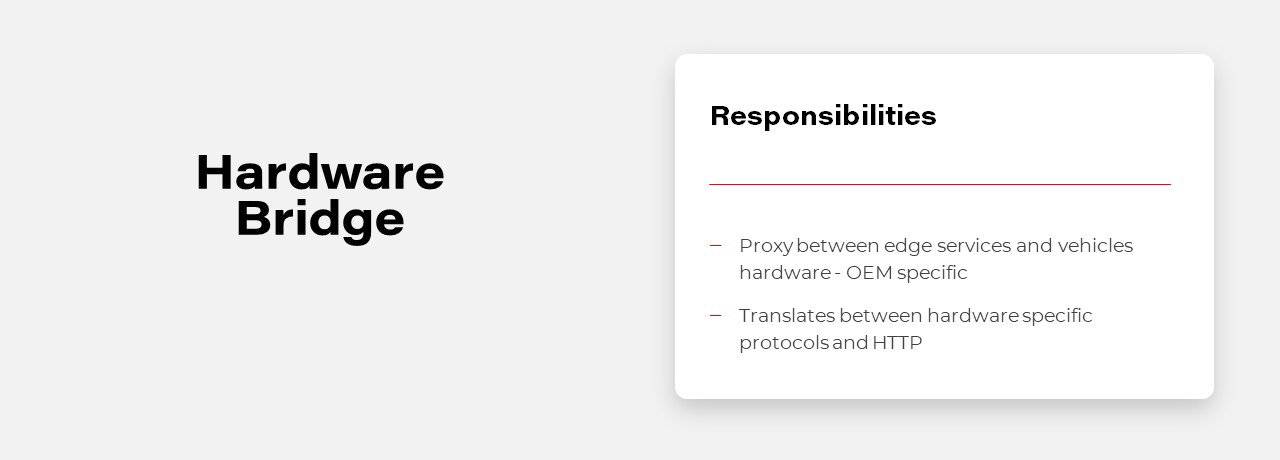
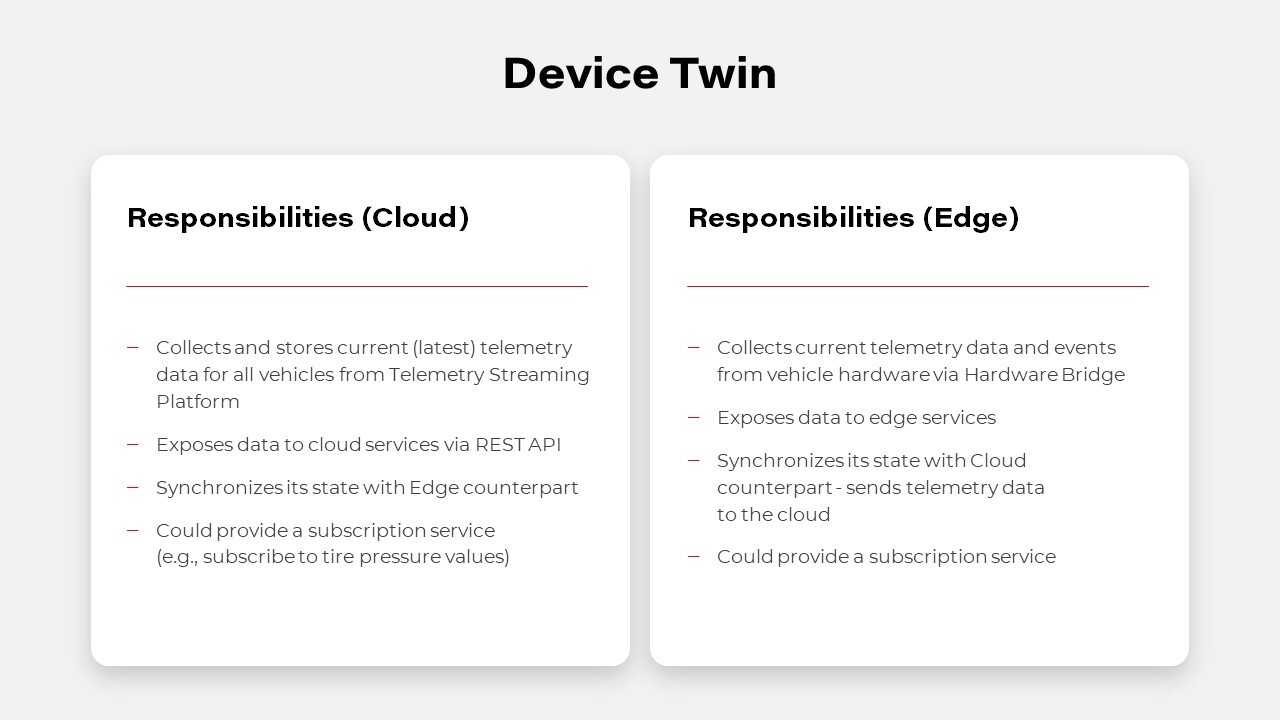
Digital Twin in Automotive
A digital twin is a virtual replica and software representation of a product, system, or process. This concept is being adopted and developed in the automotive industry, as carmakers utilize its powerful capabilities to increase customer satisfaction, improve the way they develop vehicles and their systems, and innovate. A digital twin empowers automotive companies to collect various information from numerous sensors, as this tool allows to capture operational and behavioral data generated by a vehicle. Equipped with these insights, the leading automotive enterprises work on enhancing performance and customize user experience, but meanwhile, they have to tackle significant challenges.
First of all, getting data from vehicles is problematic. Hardware built-in vehicles have particular limits, which leads to reduced capabilities in providing software. Unlike software, once shipped hardware cannot be easily adjusted to the changing conditions and works for several years at least. Furthermore, while willing to deliver a customer-centric experience, automakers still have to protect their users from numerous threats. To protect vehicles from denial of service attacks, vehicles can throttle the number of requests. Overall, it’s a good idea but can have a terrible impact when multiple applications are trying to get data from vehicles, e.g., in the rental domain. This complex problem can be simply solved by Digital Twin. It can expose data to all applications without them needing to connect to the vehicle by simply gathering all real-time vehicle data in the cloud.
Implementation of this pattern is possible by using NoSQL databases like MongoDB or Cassandra and reliable communication layers, examples are described below. Digital Twin may be implemented in two possible ways, uni- or bidirectional.
Unidirectional Digital Twin
Unidirectional Digital Twin is saving only values received from the vehicle, in case of conflict it resolves the situation based on event timestamp. However, it doesn’t mean that the event causing the conflict is discarded and lost, usually every event is sent to the data platform. The data platform is a useful concept for data analysis and became handy when implementing complex use cases like analyzing driver habits.
Bidirectional Digital Twin
The Bidirectional Digital Twin design is based on the concept of the current and desired state. The vehicle is reporting the current state to the platform, and on the other hand, the platform is trying to change the state in the vehicle to the desired value. In this situation, in case of conflict, not only the timestamp matters as some operations from the cloud may not be applied to the vehicle in every state, eg., the engine can’t be disabled when the vehicle is moving.
However, meeting the goal of developing a Digital Twin may be tricky though as it all depends on the OEM and provided API. Sometimes it doesn’t expose enough properties or doesn’t provide real-time updates. In such cases, it may be even impossible to implement this pattern.
API
At first, designing a Connected Cars API isn’t different from designing an API for any other backend system. It should start with an in-depth analysis of a domain, in this case, automotive. Then user stories should be written down, and with that, the development team should be able to find common parts and requirements to be able to determine the most suitable communication protocol. There are a lot of possible solutions to choose from. There are several reliable and high-traffic oriented message brokers like Kafka or hosted solutions AWS Kinesis. However, the simplest solution based on HTTP can also handle the most complex cases when used with Server-Sent Events or WebSockets. When designing API for mobile applications, we should also consider implementing push notifications for a better user experience.
When designing API in the IoT ecosystem, you can’t rely too much on your connection with edge devices. There are a lot of connectivity challenges, for example, a weak cellular range. You can’t guarantee when your command to a car will be delivered, and if a car will respond in milliseconds or even at all. One of the best patterns here is to provide the asynchronous API. It doesn’t matter on which layer you’re building your software if it’s a connector between vehicle and cloud or a system communicating with the vehicle’s API provider. Asynchronous API allows you to limit your resource consumption and avoid timeouts that leave systems in an unknown state. It’s a good practice to include a connector, the logic which handles all connection flaws. Well designed and developed connectors should be responsible for retries, throttling, batching, and caching of request and response.
OEM’s are now implementing a unified API concept that enables its customers to communicate with their cars through the cloud at the same quality level as when they use direct connections (for example using Wi-Fi). This means that the developer sees no difference in communicating with the car directly or using the cloud. What‘s also worth noting: the unified API works well with the Digital Twin concept, which leads to cuts in communication with the vehicle as third-party apps are able to connect with the services in the cloud instead of communicating directly with an in-car software component.
What’s Next for Connected Car Technology
Once the challenges become tackled, connected vehicles provide automakers and adjacent industries with a chance to establish beneficial co-operations, build new revenue streams, or even create completely new business models. The possibilities delivered thanks to over-the-air communication (OTA) allowing to send fixes, updates, and upgrades to already sold cars, provide new monetization channels, and sustain customer relationships.
As previously mentioned, the global connected car market is projected to reach USD 215.23 billion by 2027. To acquire shares in this market, automotive companies are determined to adjust their processes and operations. Among key factors that impact the development of connected car technology, we can point out a few crucial. The average lifecycle of a car is about 10 years. Today, automakers make decisions regarding connected cars that will go into production two to four years from now. For the cellular connectivity strategy to remain relevant over 12 to 15 years, significant challenges and assumptions need to be collaboratively addressed by OEMs, telematics control unit suppliers, and service providers.
Automakers must manage software in the field reliably, cost-efficiently, and, most importantly, securely – not just patch fixes, but also continually upgrade and enhance the functionality. The availability of OTA updates reduces the burden on dealerships and certified repair centers but requires better and more extensive testing, as the breakage of critical features is not an option.
Cellular solutions need to be agile to be compatible with emerging network technologies over the vehicle lifetime, e.g., 5G to be the industry standard in the next few years. The chosen solution must deliver reliable, seamless, uninterrupted coverage in all countries and markets where the vehicles are sold and driven.
Solution developers must offer scalable, cost-effective ways to develop upgradeable software that can be universally deployed across technologies, hardware, and chipsets. A huge focus must be put on testing the changes automatically on both the cloud platform side and the vehicle side.
As Connected Vehicles proliferate, the auto industry will need to adapt and transform itself into the growing technological dependency. OEMs and Tier-1 manufacturers must partner with technology specialists to thrive in an era of software-defined vehicles. As connectivity requires skills and capabilities outside of the OEMs’ domain, automakers will necessarily have to be software developers. An open platform environment will go a long way to encourage external developers to design apps for vehicle connectivity platforms.
Published at DZone with permission of Marcin Wisniewski. See the original article here.
Opinions expressed by DZone contributors are their own.

Comments